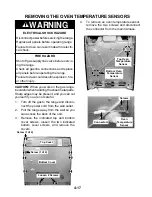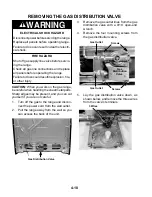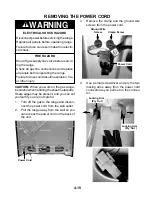
5-4
ELECTRICAL SHOCK HAZARD
Disconnect power before servicing.
Replace all panels before operating.
Failure to do so could result in death or
electrical shock.
WARNING
THE GAS DISTRIBUTION VALVE
The gas distribution valve can be converted to
L.P. gas, when necessary. It regulates the dis-
tribution of gas to the cooktop and both oven
burners. The gas distribution valve is non-ser-
viceable.
The gas distribution valve is made up of the
following features:
• Natural & L.P. gas regulator
• Manual oven shutoff valve
• Bake & broil solenoids
• Pressure tap - To measure gas outlet
pressure
The bake and broil gas supply ports are opened
and closed by electrically-operated solenoids.
When voltage is received from the spark
ignition control for the bake or broil function,
(8-18 VDC), the solenoid for that function is
activated, and the valve opens to allow gas
flow to the burner. The electrical connections
at the valve consist of three terminals, each
one sized differently to prevent incorrect wir-
ing.
TEST PROCEDURE
Solenoid Resistance Tests
Refer to page 4-18 for the procedure for servic-
ing the gas distribution valve.
1.
Disconnect the electrical power to the
range.
2.
Pull the range away from the wall and
remove the top rear cover.
J1 Connector
6.
Touch the ohmmeter test leads to J1 ter-
minals 3 and 2 (Bake). The meter should
indicate 216
Ω
±
30.
NOTE: Always check both solenoids. If one of
the solenoids is defective, neither one will op-
erate.
4.
Set the ohmmeter to the R x 10 scale.
5.
Touch the ohmmeter test leads to J1 ter-
minals 1 and 2 (Broil). The meter should
indicate 216
Ω
±
30.
3.
From the back of the control panel, discon-
nect the J1 connector at the direct spark
ignition control.
J1 Connector
2 (orange)
1 (red)
3 (blue)
Gas Distribution Valve
Solenoid Terminals











































